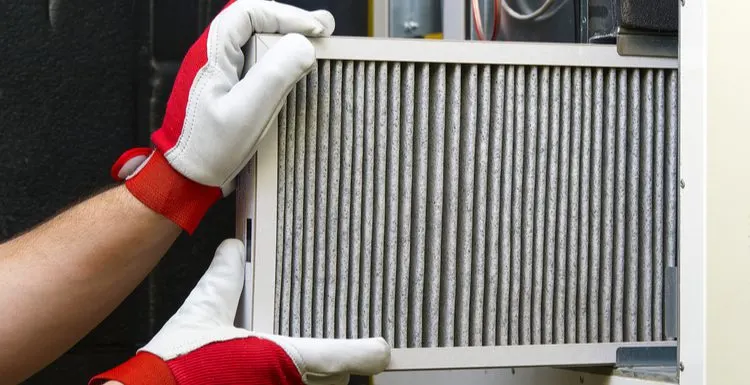Wondering how often to change your furnace filter? You’re not alone.
Most homeowners have no idea. That’s why we made this guide. Read on to learn when to change your furnace filter and why it matters.
How Often to Change Furnace Filter
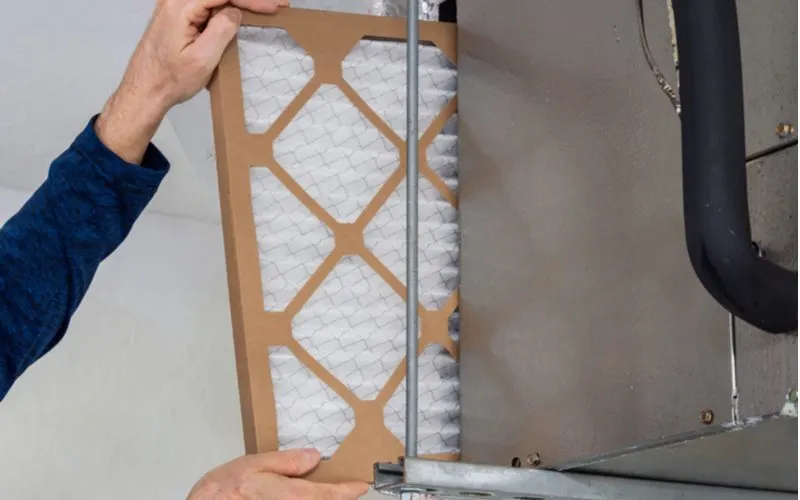
The Toidi/Shutterstock
82% of Americans don’t change their furnace filter as often as they should, with most people not changing it because they don’t know how.
If you’re among the many folks confused about how often to change the furnace filter, don’t fret. The process is simple once you know the correct steps.
For better efficiency in your HVAC unit, you should change your furnace filter every 30 days. This ensures the system processes clean, filtered air.
It also lets air flow freely through the filter, reducing strain on the furnace. And changing a filter is easy. Just follow these basic steps:
- Turn your furnace off
- Remove the door panel and locate the filter
- Slide-out your existing filter
- Determine the correct filter size
- Insert your new filter
- Close your access panel and turn on your furnace
How to Change Your Furnace Filter in 6 Steps
You shouldn’t have a problem changing your furnace filter if follow the correct steps. To save yourself a trip to the store, be sure to have the right replacement filter before you start.
1. Turn Your Furnace Off
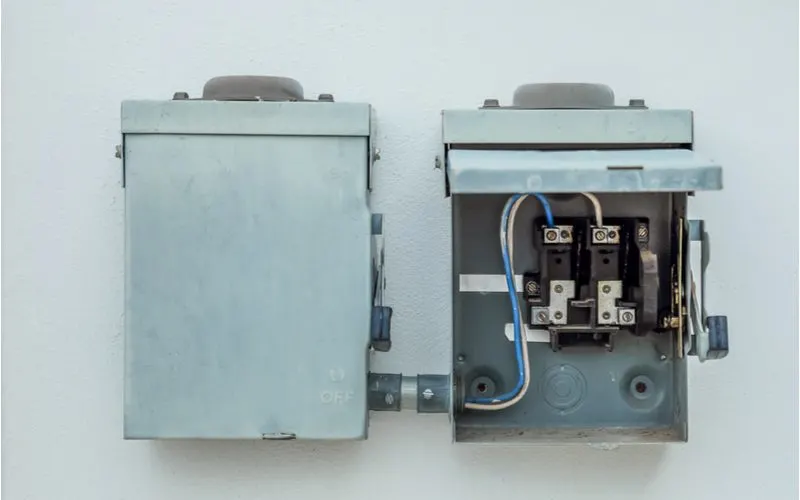
Anucha Cheechang/Shutterstock
Before changing your filter, ensure that your HVAC is off. When shutting off your system, start by turning off your thermostat.
Every thermostat setting is different, so follow the options provided by your model’s user manual.
Then go outside and locate the power to your external unit. Flip the switch to turn it off.
2. Remove the Door Panel to Locate Your Filter
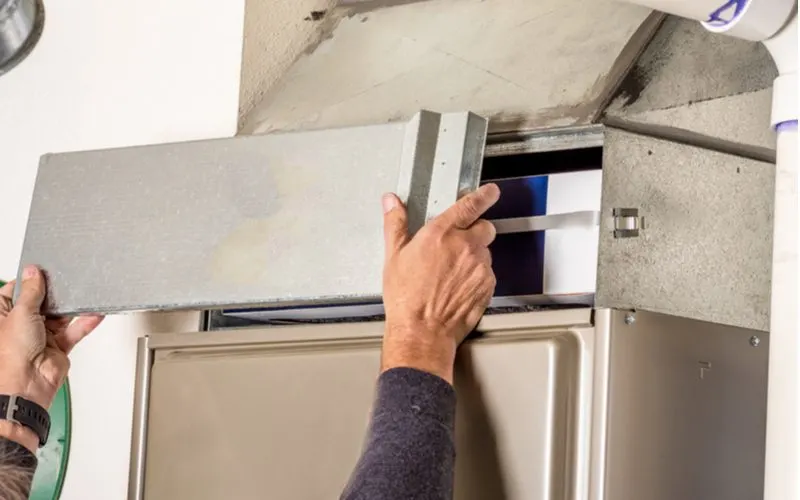
Charles Knowles/Shutterstock
The easiest way to locate your filter is to refer to your HVAC system user manual. If you don’t have your manual, check your HVAC unit and try to locate the air ducts that connect to the outside (blowing air out) and inside (bringing air in) of your home.
You’ll find the filter between the air ducts that carry air both into your home and the furnace body. While this may be the case with most HVAC systems, the location will vary depending on the installation of the furnace.
For instance, in the up-flow furnace (air moving upwards), you’ll find your filter at the bottom door of your blower compartment.
To access the filter, you’ll have to open the top and bottom doors. When closing your bottom door, ensure that you place it over your furnace frame and that it engages your furnace safety switch.
If you fail to do this, then your furnace won’t run. If you have a down-flow furnace (air moves in a downward direction), you’ll find your filter in the upper blower compartment.
Most downflow furnaces feature a V-shaped filter system that can hold two filters. If you have a horizontal furnace, a slide-in furnace rack is built into your furnace.
3. Slide Out Your Existing Filter
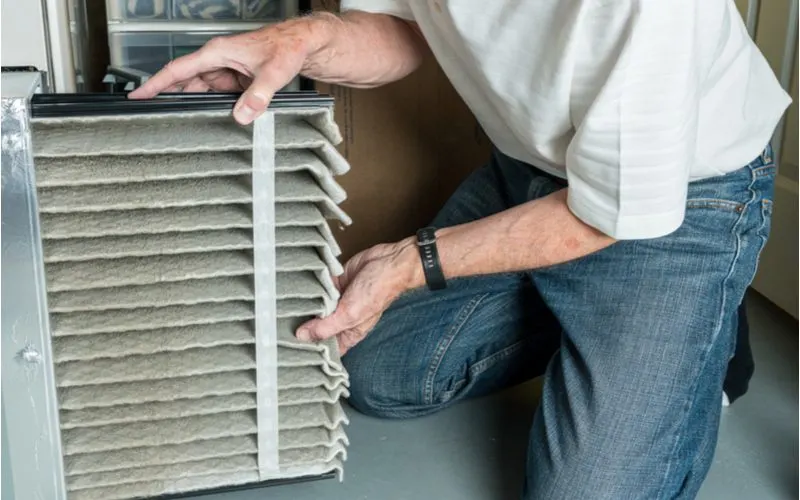
Steve Heap/Shutterstock
Depending on the location of your filter, you may need to remove several screws before accessing it.
Don’t forget to place them in a bag or box so that you can easily access them. Carefully pull the filter with both hands and determine whether you should replace it based on debris buildup.
If you find any resistance, chances are high that there’s a locking mechanism securing it in place.
Look carefully for such a system, then undo its lock to remove the filter. When removing your air filter, check the arrow on your filter frame that indicates the right airflow direction.
Ensure that you install your new filter in the same direction as your old one. You should also know that the furnace filter has a MERV rating, which measures its efficiency in capturing pollutants as they move through your HVAC system.
A MERV rating of 1 indicates that it’s not working well, while 18 means it’s working as efficiently as possible.
A recent study on air filters and allergic respiratory diseases showed that efficient medium filters (MERV 7–12) offer the best balance between filter cost and allergen removal.
4. Find the Right Size Filter
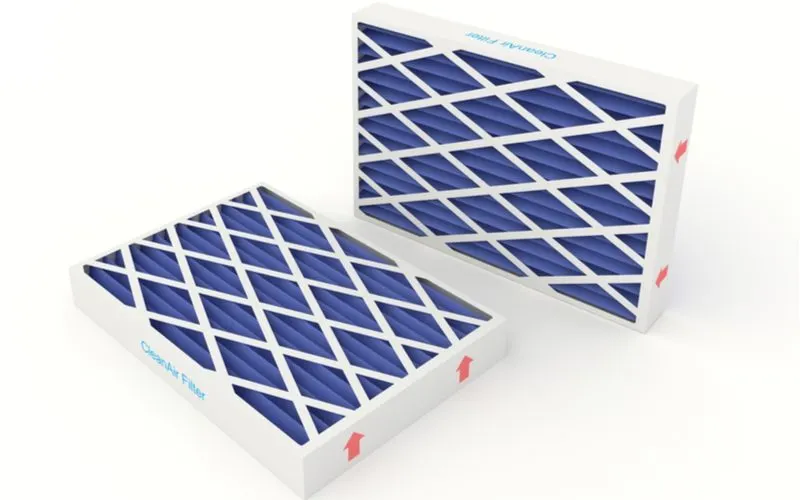
William E. Fehr/Shutterstock
Before you determine the size of your furnace air filter, check the manual to see whether it has a recommendation on the ideal size to buy. If it doesn’t indicate it, remove your filter. The size should be printed on the old filter.
Note the size so you can refer to the information the next time you’re shopping for a new filter. If you cannot find this information, use a ruler or tape measure to get the dimensions of its thickness, width, and height.
When shopping for a furnace filter, you may opt for the cheaper options made of fiberglass with cardboard frames. Such filters help to trap airborne particles, dirt, and dust before they enter your system.
You may also want to opt for the more expensive option (the HEPA filter) if you have family members with allergies, as it traps mold spores, pollen, and bacteria.
5. Insert Your New Filter
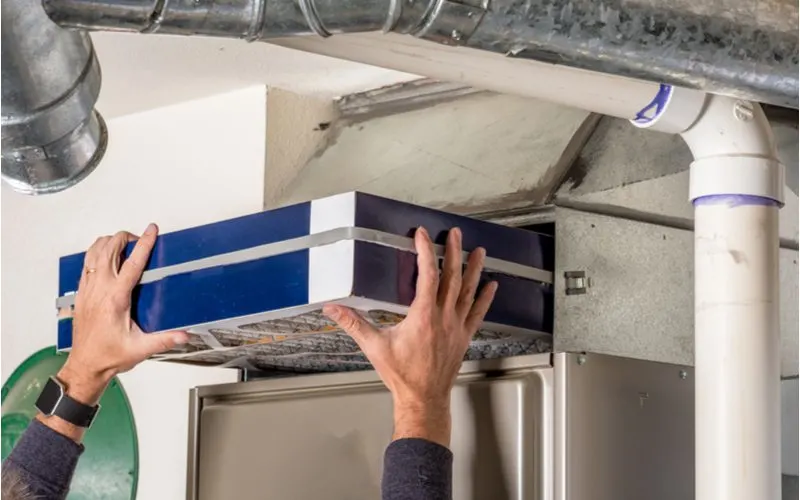
Charles Knowles/Shutterstock
Your furnace filter traps dust and other pollutants from one direction. This is designed to ensure that when it loads up, it doesn’t collapse or fall apart.
As you insert your new filter, note the arrow, which indicates the airflow direction. This will help you determine the right way to slide your filter into your furnace.
In most HVAC units, you’ll need to slide the new filter with the arrow facing your furnace blower motor. If you put your filter backwards, your furnace will have insufficient airflow, causing it to overheat and turn off.
When you’re done, slide your furnace access door, and you’ll be ready to use it for another month. If you use your furnace regularly or have furry pets, you may need to change your filter regularly.
The Department of Energy reports that changing your air filter at least once a month will reduce HVAC energy consumption by as much as 15%.
6. Turn Your Furnace to the “On” Position
Once you have replaced your furnace, turn your thermostat to the “ON” position.
Your furnace is safe from loose debris and dirt, and it’s safe to run it normally.
Don’t forget to note the date you changed your filter so that you can recheck it after a month.
Things to Consider
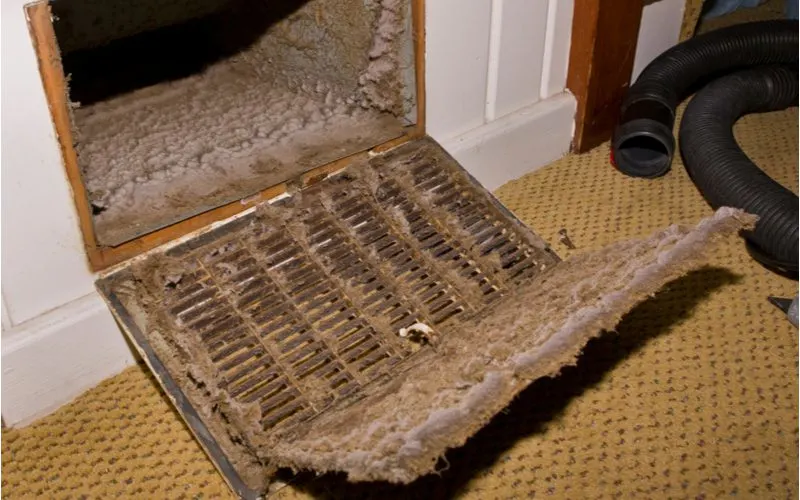
Rob Crandall/Shutterstock
Now that you better understand changing your furnace filter, here are a few essential considerations to remember:
- When changing your air filter, ensure that you get the right size. Reusable furnace filters will have a plastic frame, while disposable ones will have cardboard frames. All these filters will have the size indicated in the filter frame. If your filter doesn’t show the size, use a measuring tape to determine the filter’s thickness, width, and length.
- Ensure that you insert your filter correctly. Most furnace filters will have an arrow that indicates your furnace filter airflow. If your furnace filter isn’t installed correctly, your HVAC unit will use more energy because it’ll have to work extra hard to pull air in.
- If there’s someone in your household with allergies, you should invest in HEPA (a highly efficient particle air filter). These types are specially designed to trap things like algae, yeast, fungus, and mildew.
- When you remove your furnace filter, confirm whether there’s a locking mechanism securing it in place. If there’s any present, slide it to release your filter.
- Depending on how your furnace was installed, you can find the filter inside the blower compartment, or it could feature a slide-in rack built into the furnace.
- There are numerous types of air filters you may want to consider. If you are looking for the basic model, disposable fiberglass filters are an ideal option. They’re effective at trapping large particles of dirt and dust, and you can dispose of them after one or two months. You may also want to consider the reusable electrostatic filters that can trap small airborne particles and smoke.
How Often Should You Change a Furnace Filter?
Frequently changing your air filter is the best way to ensure that your furnace is running efficiently and to help purify the air in your home. Proper placement of the filter is necessary to keep it running efficiently.
For instance, if you insert it incorrectly, it’ll have to work hard to provide better indoor air quality, which translates into increased energy bills. Some furnace filters may not have the dimensions indicated.
In this case, measure its height, width, and depth to ensure that you’re getting a suitable replacement. Once you know how to change your air filter, consider making it a regular exercise.
You should change your air filters once a month, but if you opt for better-quality options like the HEPA filter, you can change them every 60 to 90 days.
Sometimes it’s easy to forget about replacing your furnace air filters, and buying them in bulk helps to reduce the chances of procrastination.
FAQs
How often should you change your furnace filter?
You should change your furnace every three months, at a minimum. If your filter gets too dirty, your furnace will over heat because it's not getting the proper airflow. Because of this reduced airflow, your furnace will need to work harder than necessary, reducing the lifespan of the appliance.
How often should you change your furnace filter in the winter?
In the winter, you should change your furnace filter at least every three months, though changing it more frequently can't hurt. In the winter, your furnace runs regularly, causing it to get dirtier than other times of the year, requiring regular changes to avoid overheating.
Should I change my furnace filter every month?
Most HVAC professionals agree that you should replace your furnace filter every 3 months. While replacing it every month might be unnecessary in most homes, if your air quality is lower than average or you have pets that shed, monthly replacement is a good idea.

